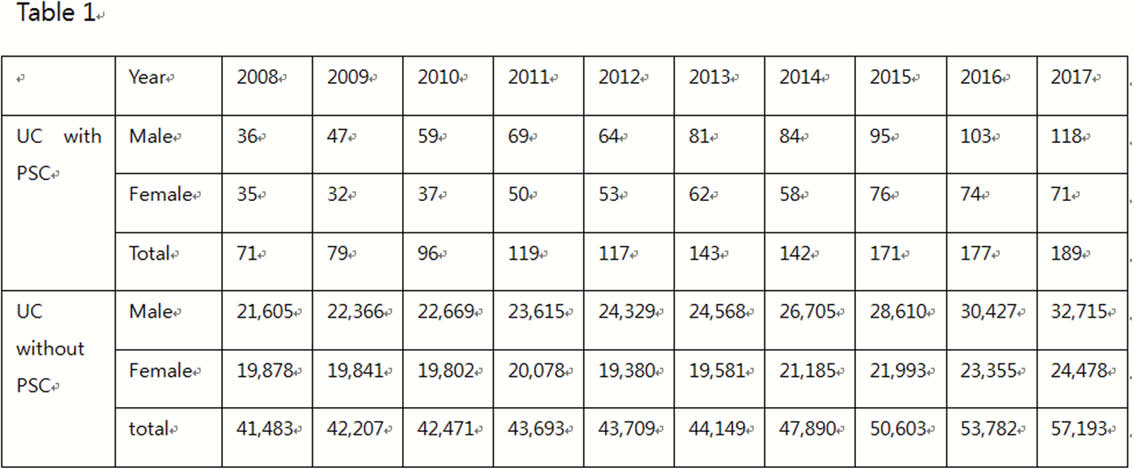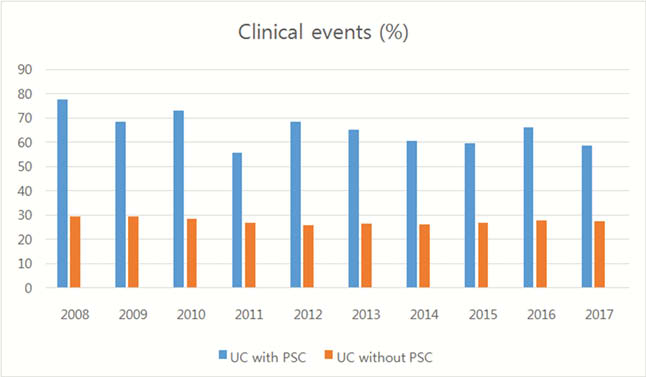P796 Annual prevalence and clinical outcomes of ulcerative colitis with primary sclerosing cholangitis in Korea over the last 10 years
S.H. Jung1, T.O. Kim2, D.H. Baek3, D.B. Kim4, G.A. Song3, H.S. Kang5, H.J. Goong6, J.H. Bae7, S. Hye Kyung8, H.S. Lee9
1Eunpyeong St. Mary’s Hospital- College of Medicine- The Catholic University of Korea, Internal Medicine, Seoul, Republic of Korea, 2Inje University Haeundae Paik Hospital, Internal Medicine, Busan, Republic of Korea, 3Pusan National University School of Medicine and Biomedical Research Institute- Pusan National University Hospital, Internal Medicine, Busan, Republic of Korea, 4St.Vincent’s Hospital- The Catholic university of Korea, Internal Medicine, Seoul, Republic of Korea, 5College of Medicine- Hallym University, Internal Medicine, Anyang, Republic of Korea, 6Soonchunhyang University Bucheon Hospital, Gastroenterology and Hepatology, Bucheon, Republic of Korea, 7Healthcare System Gangnam Center- Seoul National University Hospital, Internal Medicine, Seoul, Republic of Korea, 8Ewha Womans University College of Medicine, Internal Medicine, Seoul, Republic of Korea, 9Inje University Busan Paik Hospital, Internal Medicine, Busan, Republic of Korea
Background
The prevalence of ulcerative colitis (UC) in Korea has recently increased significantly, but there is few data for the prevalence and clinical outcomes of primary sclerosing cholangitis (PSC) associated UC. Thus, we assessed the prevalence of primary sclerosing cholangitis (PSC)and analysed clinical outcomes in Korean UC patients.
Methods
National Health Insurance System (NHIS) claim data from 2008 to 2017 were used in this population-based study. UC patients and PSC patients were identified by codes for ulcerative colitis (UC: K51) and (PSC: K830) in the NHIS registration system. Clinical events were defined as emergency department visit, hospitalisation, colectomy and liver transplantation.
Results
The overall number of UC with PSC & without PSC patients has increased steadily (Table 1). The prevalence of PSC in UC patients has increased since 2008 and was 0.33%in 2017.Clinical events were more frequent in UC with PSC, but the incidence of clinical events has decreased since 2008 in both groups (Figure 1).In 2017, the number of UC with PSC was 189 (male;118 vs. female;71) and the mean age of UC with PSC was 50.82 years(vs. UC without PSC;49.74). The incidence was low in teenagers and there was no difference in prevalence by age group.


Conclusion
This study confirmed that the prevalence of PSC is increasing in Korea. Additionally, UC with PSC patients have poor clinical outcomes. Therefore, the prevalence of PSC in UC patients suggests the need for greater attention and effort in clinical practice.


